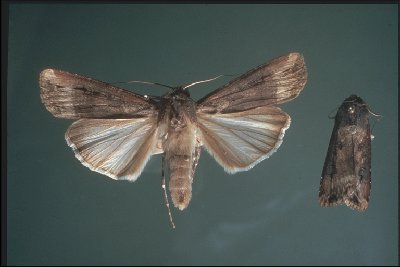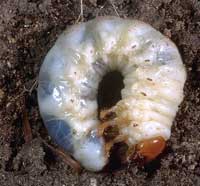 Stalk rots
Stalk rotsWith corn harvest well underway, many producers are dealing with corn lying on the ground. Winds associated with Hurricane Ivan were clearly a major factor in causing corn lodging this year, but growing conditions also played a role.

 Stalk rots
Stalk rots
With corn harvest well underway, many producers are dealing with corn lying on the ground. Winds associated with Hurricane Ivan were clearly a major factor in causing corn lodging this year, but growing conditions also played a role.
The drought stress following silking that many areas experienced this season probably led to reduced stalk strength and to stalks rots in many instances. Grain fill is a period of heavy demand for photosynthate (the products of photosynthesis), and drought stress at that time can reduce stalk strength. Here is how this happens. Within the plant, biosynthetic metabolic pathways including photosynthesis are sensitive to even mild water stress, so less photosynthate is produced by plants when water becomes limited. Yet plants under water stress will still attempt to fill the grain. However, when photosynthesis cannot meet the demand, the plants draw carbohydrates from the stalk. This weakens the stalk, and it sets it up for invasion by stalk-rot fungi.
In addition to late-season drought, other factors that can increase the risk of stalk rots and lodging. High plant populations are probably top on the list. High nitrogen level can also increase the stalk rot risk. Ear set in a high position on the plant can also increase the risk, by making the plant top-heavy.
Foliar fungicide applications have been shown to sometimes result in enhanced stalk health in corn. However, I have only seen this effect in studies where the fungicides provided control of aggressive leaf disease activity (gray leaf spot and/or northern leaf blight). I know of no studies showing enhanced stalk health from fungicides where foliar diseases were at low levels, which is generally the case in Kentucky this year. Therefore, I don't expect to see much benefit on stalk health from fungicide applications made this summer.
Ear rots and Mycotoxins
Lodging of corn puts ears close the ground, where high moisture conditions can slow drying and promote ear rots. In most areas, dry weather since Hurricane Ivan has helped to reduce this risk, but producers should keep in mind that the potential for ear molds increases in downed corn, so it should be harvested as soon as is practical.
Mycotoxins are toxins produced by fungi. There are several that can be produced in Kentucky corn under particular conditions, the most notorious being aflatoxins and fumonisins. I have not heard of reports of significant levels of mycotoxin contamination in this year's corn crop. However, the dry conditions during silking and grain fill experienced by many crops can enhance the risk of mycotoxin contamination. Kernels infected in the field may develop mycotoxins prior to harvest, but the greater risk is development of mycotoxins in storage, especially if the shelled grain is not dried promptly and stored properly.
More information on ear molds and mycotoxins can be found in the following Extension publications:
Aflatoxins in Corn, http://www.ca.uky.edu/agc/pubs/id/id59/id59.pdf
Fumonisin, Vomitoxin, and Other Mycotoxins in Corn Produced by Fusarium Fungi, http://www.ca.uky.edu/agc/pubs/id/id121/id121.pdf
Moldy Grains, Mycotoxins, and Feeding Problems, http://www.oardc.ohio-state.edu/ohiofieldcropdisease/Mycotoxins/mycopagedefault.htm
For information about corn pests, visit
"Insect Management Recommendations".


 The number of fall armyworm (FAW) moths captured in UK-IPM pheromone baited traps is increasing. At present the numbers have surpassed the five year average, though they have not yet reached the 2007 numbers. If the rate of increase continues, we could face an outbreak situation. This same increase occurred in 2007 and the counts reached very large numbers near 400 moths per trap week, at the peak catch. The 2007 moth flight resulted in some larval populations in wheat and forages that required treatment. Additionally, the problem was considerable in west Tennessee, with a number of forage fields being treated.
The number of fall armyworm (FAW) moths captured in UK-IPM pheromone baited traps is increasing. At present the numbers have surpassed the five year average, though they have not yet reached the 2007 numbers. If the rate of increase continues, we could face an outbreak situation. This same increase occurred in 2007 and the counts reached very large numbers near 400 moths per trap week, at the peak catch. The 2007 moth flight resulted in some larval populations in wheat and forages that required treatment. Additionally, the problem was considerable in west Tennessee, with a number of forage fields being treated.
This year two things are different, for at least parts of the state. First, the increase is occurring later in the year, than in 2007. This would place any fall armyworm egg hatch closer to the time of "killing" frost. That would mean the larvae would be less damaging than if they had occurred earlier. Additionally, because of our very dry conditions, very little of our small grain acres have been planted, and there is as yet, little volunteer corn. Certainly the FAW moths are going to lay their eggs on something. But as long as that site is some wild host outside our production fields, then our crops are not endangered. In the cases where small grains are out of the ground, especially if the fields contain volunteer corn, these fields should be scouted for the presence of FAW worms.
This flight many not develop into anything significant but is worth watching. The crops at risk are small grains and grass forages.
 White grub feeding damage may be the reason sod rolls up as a chain harrow is pulled across a pasture. This can be confirmed by inspecting the soil for larvae. Check brown areas by tugging on the turf to see if the root system in intact or missing due to grub feeding. Damage may be localized. Female beetles may concentrate egg-laying in low areas or where soil moisture is highest, or grub survival may be better. This would lead to hotspots that could be avoided while other areas of pastures could be harrowed without injury.
White grub feeding damage may be the reason sod rolls up as a chain harrow is pulled across a pasture. This can be confirmed by inspecting the soil for larvae. Check brown areas by tugging on the turf to see if the root system in intact or missing due to grub feeding. Damage may be localized. Female beetles may concentrate egg-laying in low areas or where soil moisture is highest, or grub survival may be better. This would lead to hotspots that could be avoided while other areas of pastures could be harrowed without injury.
Most grub feeding occurs in the fall and should be near its peak. Root damage will begin to decline as grubs move deeper into the soil to pass the winter. This usually occurs after the first frost. Postponing pasture dragging will give grass some chance to recover and will avoid turning over more loose turf.
Root damage can be caused by one or combinations of several species including Japanese beetles and masked chafers. There are no practical control options at this point. Large grubs are difficult to kill under the best of circumstances. It is unlikely that product plus application costs could be recovered, especially when irrigation or rainfall is needed to move the insecticide into the soil where grubs are feeding.
 Female green June beetles lay their eggs where organic matter is abundant because this is food for their larvae. Seeding failures can occur as these white grubs churn up the surface soil and uproot emerging seedlings. If infestations are caught early enough, an application of Sevin may reduce damage.
Female green June beetles lay their eggs where organic matter is abundant because this is food for their larvae. Seeding failures can occur as these white grubs churn up the surface soil and uproot emerging seedlings. If infestations are caught early enough, an application of Sevin may reduce damage.
Green June beetle larvae are typical white grubs but have a unique behavior that makes them occasional but serious pests in late summer or fall seedings. Most white grubs remain below the soil surface and feed on plant roots. Green June beetle grubs frequently travel to and on the surface while feeding. They are most common around rotting hay, silage, or animal manure, such as fields under an intensive grazing regime.
Seedlings are uprooted as grubs plow along the soil surface. Their churning breaks soil breaking root- soil contact which kills seedlings. This creates dead spots or unacceptably thin stands, and produces bare areas that allow weed emergence. Numbers can be high in established grass or alfalfa fields but the damage potential is not as great.
The green June beetle grub is dirty white with a reddish brown head and legs. They may be found just below the surface in areas where the soil has been disturbed. The grubs typically move on the surface at night but may be forced up by heavy rain or flooding. The presence of 3 to 4 grubs per square foot can disrupt new stands, heavy infestations can have densities of 15 to 20 grubs per square foot. Grubs can move 60 feet or more along the surface in search of higher concentrations of organic matter.
Since green June beetle grubs move to and across the soil surface, they are susceptible to an insecticide application. However, they tend to die and rot on the surface, which produces a very unsatisfactory situation. In addition, birds feeding on these grubs may be poisoned. There is nothing to gain from a treatment at this time.
In Kentucky, green June beetle adults begin to emerge from the soil in late June. The population peaks in the last half of July and most are dead by mid-August. Females lay clusters of about 40 eggs a few inches below the soil surface of soil rich in organic matter. The eggs hatch in about two weeks and the larval stage is present until pupation in late May or early June. The pupal stage occurs in an earthen cell in the soil and lasts 2 to 3 weeks. There is one generation per year.


 Clients soon may be calling about lady beetles congregating on the sides of homes and infesting buildings. This phenomenon has become an all-too-common autumn event throughout Kentucky and much of the United States. The culprit is the Asian lady beetle, Harmonia axyridis, in search of protected places to spend the winter. In Kentucky, movement into buildings typically begins in mid-October, continuing through mid-November.
Clients soon may be calling about lady beetles congregating on the sides of homes and infesting buildings. This phenomenon has become an all-too-common autumn event throughout Kentucky and much of the United States. The culprit is the Asian lady beetle, Harmonia axyridis, in search of protected places to spend the winter. In Kentucky, movement into buildings typically begins in mid-October, continuing through mid-November.
Detailed information on this perennial problem is contained in ENT-64, Asian Lady Beetle Infestation of Structures. Key points include:

NOTE: Trade names are used to simplify the information presented in this newsletter. No endorsement by the Cooperative Extension Service is intended, nor is criticism implied of similar products that are not named.
Lee Townsend
Extension Entomologist